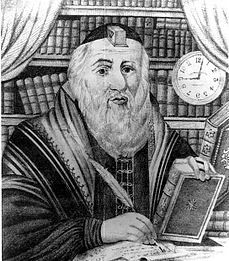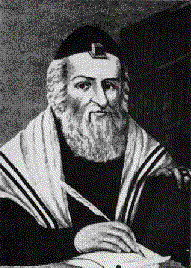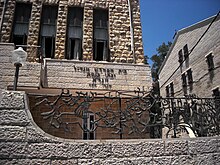Vilna Gaon
Elijah ben Solomon Zalman | |
|---|---|
 Vilna Gaon | |
| Title | Vilna Gaon Elijah of Vilna Gra |
| Personal | |
| Born | Elijah ben Solomon Zalman April 23, 1720 |
| Died | October 9, 1797 (aged 77) |
| Religion | Judaism |
| Nationality | Polish-Lithuanian |
| Denomination | Orthodox Judaism |
| Yahrtzeit | 19 Tishrei |
| Buried | Vilnius,Lithuania |
Elijah ben Solomon Zalman,[1](Hebrew:ר' אליהו בן שלמה זלמןRabbi Eliyahu ben Shlomo Zalman), also known as theVilna Gaon[2](Yiddish:דער װילנער גאוןDer Vilner Goen;Polish:Gaon z Wilna, Gaon Wileński;orElijah of Vilna,or by his HebrewacronymGra( "GaonRabbenuEliyahu ":" Our great teacher Elijah ";Sialiec,April 23, 1720 –VilniusOctober 9, 1797), was aLithuanian JewishTalmudist,halakhist,kabbalist,and the foremost leader ofmisnagdic(non-hasidic)Jewryof the past few centuries.[3][4][5]He is commonly referred to in Hebrew asha-Gaon mi-Vilna,"the genius from Vilnius".[6]
Through his annotations and emendations of Talmudic and other texts, he became one of the most familiar and influential figures in rabbinic study since theMiddle Ages.Although he is chronologically one of theAcharonim,some considered him one of theRishonim[7][8][9]
Large groups of people, including manyyeshivas,uphold the set ofJewishcustoms and rites (minhag), the "minhag ha-Gra",named after him, and which is also considered by many to be the prevailingAshkenaziminhaginJerusalem.[citation needed]
Born in Sielec in theBrest Litovsk Voivodeship(todaySialiec,Belarus), the Gaon displayed extraordinary talent while still a child. By the time he was twenty years old, rabbis were submitting their most difficulthalakhicproblems to him for legal rulings. He was a prolific author, writing such works asglosseson theBabylonian TalmudandShulchan Aruchknown asBi'urei ha-Gra( "Elaborations by the Gra" ), a running commentary on theMishnah,Shenoth Eliyahu( "The Years of Elijah" ), and insights on thePentateuchentitledAdereth Eliyahu( "The Cloak of Elijah" ), published by his son. Various Kabbalistic works have commentaries in his name, and he wrote commentaries on theProverbsand other books of theTanakhlater on in his life. None of his manuscripts were published in his lifetime.
WhenHasidic Judaismbecame influential in his native town, the Vilna Gaon joined the "opposers" orMisnagdim,rabbis and heads of the Polish communities, to curb Hasidic influence.[citation needed]
While he advocated studying branches of secular education such asMathematicsin order to better understand rabbinic texts, he harshly condemned the study ofPhilosophyandMetaphysics.[10][11]
Youth and education[edit]
The Vilna Gaon was born inSialiec,Polish–Lithuanian Commonwealthon April 23, 1720, as Elijah Ben Solomon Zalman to a well known rabbinical family.[4]
According to legend he had committed theTanakhto memory by the age of four, and aged seven he was taughtTalmudbyMoses Margalit,future rabbi ofKėdainiaiand the author of a commentary to theJerusalem Talmud,entitledPnei Moshe( "The Face of Moses" ).[4]He possessed aphotographic memory.By eight, he was studyingastronomyduring his free time. From the age of ten he continued his studies without the aid of a teacher, and by the age of eleven he had committed the entire Talmud to memory.
Later he decided to go into "exile" and he wandered in various parts of Europe includingPolandandGermany.[12]By the time he was twenty years old, rabbis were submitting their most difficulthalakhicproblems to him. He returned to his native city in 1748, having by then acquired considerable renown.[13]
Methods of study[edit]
The Gaon applied rigorous philological methods to theTalmudand rabbinic literature, making an attempt toward a critical examination of the text.
He devoted much time to thestudy of the TorahandHebrew grammar,and was knowledgeable in scientific pursuits of the time.[14]
Antagonism to Hasidism[edit]

WhenHasidic Judaismbecame influential inVilna,the Vilna Gaon joined rabbis and heads of the Polish communities, to speak against Hasidic influence.[10][15]
In 1781, when the Hasidim renewed their proselytizing work under the leadership of their RabbiShneur Zalman of Liadi(the "Ba'al Ha'tanya" ), the Gaon excommunicated them again, declaring them to be heretics with whom no piousJewmight intermarry.
Other work[edit]
Except for the conflict with the Hasidim, the Vilna Gaon rarely engaged in public affairs and, so far as is known, did not preside over any school inVilna.He was satisfied with lecturing in hisbet ha-midrashto a few chosen pupils, whom he initiated into his methods. He taught themHebrew grammar,Hebrew Bible,andMishna,subjects that were largely neglected by theTalmudistsof that time. He was especially anxious to introduce them to the study ofmidrashliterature, and theMinor Treatisesof the Talmud, which were very little known by the scholars of his time.[citation needed]
He laid special stress on the study of theJerusalem Talmud,which had been almost entirely neglected for centuries. The Gaon encouraged his chief pupil, RabbiChaimofVolozhin,to found ayeshiva(rabbinic academy) in which rabbinic literature should be taught. Rabbi Chaim Volozhin opened theVolozhin yeshivain 1803, a few years after the Gaon's death, and revolutionized Torah study, with resulting impact on all ofOrthodox Jewry.[16]
Asceticism[edit]

The Vilna Gaon led anasceticlife, being called by some of his contemporaries "theHasid".This term meaning" pious person ", and has no relevance to theHasidicmovement.[citation needed]
The Gaon once started on a trip to theLand of Israel,but for unknown reasons did not get beyondGermany.(In the early nineteenth century, three groups of his students, known asPerushim,under the leadership of Rabbi Menachem Mendel of Shklov, made their way to what was then Ottoman Palestine, settling first inSafedand later also inJerusalem).[17]While atKönigsberghe wrote to his family a famous letter that was published under the titleAlim li-Terufah,Minsk,1836.
Works[edit]
The Vilna Gaon was a copious annotator, producing many marginal glosses, notes, and brief commentaries, which were mostly dictated to his pupils. Many maintain that it was his disciples who recorded his comments, if not his editorial notes. However, nothing of his was published in his lifetime. The "Gra" was very precise in the wording of his commentaries, because he maintained that he was obligated by Torah Law that only the "Torah shebichtav"(the written law) is permitted to be written down - the rest of"Torah sheb'al peh"(oral law) cannot be, unless circumstances require. (This further supports the view that it was his disciples who wrote his comments.) So the Vilna Gaon abided by this view of law by reducing his extensive explanations that are largely inscrutable to any but advanced talmudists. Glosses on theBabylonian TalmudandShulchan Aruchare known asBi'urei ha-Gra( "Elaborations by the Gra" ). His running commentary on theMishnahis titledShenoth Eliyahu( "The Years of Elijah" ). VariousKabbalisticworks have commentaries in his name. His insights on thePentateuchare titledAdereth Eliyahu( "The Splendor of Elijah" ). Commentaries on theProverbsand other books of theTanakhwere written later on in his life.
He was well versed in the mathematical works ofEuclid(4th century BC) and encouraged his pupil RabbiBaruch Schick of Shklovto translate these works into Hebrew. The Gaon is said to have written a concise mathematical work calledAyil Meshulash,which was an introductory primer to basic mathematics.[14][18][19]
Influence[edit]


He was one of the most influential rabbinic authorities since theMiddle Ages,and—although he is properly anAcharon—many later authorities hold him as possessing halachic authority in the same class as theRishonim(rabbinic authorities of the Middle Ages).
His main student RabbiChaim Volozhin,founded the firstyeshivain his home town ofVolozhin,Belarus.[16]The results of this move is claimed to have revolutionizedTorah study,by departing from the centuries of 'informal' study. Youth and scholars would congregate in local synagogues and study freely, although it was customary to migrate to towns possessing great scholars as the local rabbi. The Volozhin Yeshivah created a formal structure of the study, by providing qualified faculty, meals, and accommodation. The results of this process are currently the norm inOrthodox Jewry.
Somewhat ironically, viewed from a traditional light, the leaders of theHaskalahmovement used the study methods of the Vilna Gaon to gain adherents to their movement. Maskilim valued and adapted his emphasis onpeshatoverpilpul,his engagement with and mastery of Hebrew grammar and Bible, and his interest in textual criticism of rabbinic texts, further developing the philosophy of their movement.
As for the Vilna Gaon's own community, in accordance with the Vilna Gaon's wishes, three groups of his disciples and their families, numbering over 500, madealiyahto theLand of Israelbetween 1808 and 1812.[20]This immigration was one of the first modern Jewish migrations to Palestine, although Hasidic immigration was already active in the 1780s (even by therebbesthemselves, such as the elderlyMenachem Mendel of VitebskandChaim Chaykl of Amdur). The disciples of the Vilna Gaon, known asPerushimdue to how they isolated themselves from worldly concerns to study Torah, originally settled inSafedbecause the Muslim authorities in Jerusalem prevented Ashkenazi Jews from settling there. However, after numerous devastating calamities in the region, including plague and earthquake, most of the disciples moved to Jerusalem. Their arrival in Jerusalem, which for over 100 years had been mainlySephardi,revived the presence ofAshkenaziJewry in Jerusalem, and resulted in a dominance of the customs of the Vilna Gaon.
The impact of the Perushim is still apparent today in the religious practices of the Israeli Jewish community, even among non-Ashkenazim. For example, the institution of the priestly blessing by the Kohanim known asduchaningduring the weekdays (rather than only during festivals, as practiced in the Diaspora), and the accepted time for the onset ofShabbatin Jerusalem and other cities can both be traced to the custom of the Vilna Gaon. However, the teachings and traditions of the Vilna Gaon have been passed down most directly to theLitvaksin Israel. The Perushim also set up severalKollels,founded the Jerusalem neighborhood ofMea Shearim,and were instrumental in rebuilding the Yehudah HeChassid Synagogue (also known as theHurba Synagogue,or "The Ruins" ), which had lain in ruins for 140 years.
There is a statue of the Vilna Gaon and a street named after him in Vilnius, the place of both his birth and his death. Lithuania's parliament declared 2020 as the year of the Vilna Gaon and Lithuanian Jewish History.[21]In his honour, theBank of Lithuaniaissued a limited-edition silver commemorative 10-eurocoin in October 2020; this is the first euro coin with Hebrew letters.[22][23]
The Vilna Gaon's brotherAvrahamauthored the revered work "Maalot Hatorah". His sonAbrahamwas also a scholar of note.
Death[edit]
The Vilna Gaon died in 1797, aged 77, and was subsequently buried in the Šnipiškės cemetery in Vilnius, now inŽirmūnai elderate.The cemetery was closed by the Tsarist Russian authorities in 1831 and partly built over.
In the 1950s, Soviet authorities planned to build a stadium and concert hall on the site. They allowed the remains of the Vilna Gaon to be removed and re-interred at the new cemetery.[24]
See also[edit]
References[edit]
- ^Within recent decades he has been given thesurnameKremer. However neither the Vilna Gaon nor his descendants apparently used this surname, which meansshopkeeper.It was possibly mistakenly derived from a nickname of his ancestor Rabbi Moshe Kremer."The Vilna Gaon, part 3 (Review of Eliyahu Stern, The Genius)".Marc B. Shapiro
- ^Yaniv, Samuel (Rabbi) (April 17, 2010)."The Vilna Gaon and his Vision of Redemption".Bar Ilan University.Archived fromthe originalon March 23, 2017.RetrievedMay 19,2012.
- ^Etkes, Immanuel; Green, Jeffrey M. (2002).The Gaon of Vilna: The Man and His Image.University of California Press.ISBN978-0-520-22394-3.JSTOR10.1525/j.ctt1pnj2v.
- ^abcCohn-Sherbok, Dan; Cohn-Sherbok, Lavinia (1994).Jewish & Christian Mysticism: An Introduction.Gracewing Publishing.ISBN978-0-85244-259-3.
- ^Eisenberg, Ronald L. (December 1, 2011).Dictionary of Jewish Terms: A Guide to the Language of Judaism.Taylor Trade Publications.ISBN978-1-58979-729-1.
- ^The Threefold step of Academia Europeana: a case of Universitas Vilnensis,2009, p. 24
- ^Karelitz, Avraham Yeshaya.קובץ איגרות חזון איש[Collected letters of the 'Chazon Ish'] (in Hebrew). pp. Part one, section 32.
אנו מתייחסים להגר "א בשורה של משה רבנו, עזרא, רבנו הקדוש, רב אשי והרמב" ם. הגר "א שנתגלה תורה על ידו כקדוש מעותד לכך שהאיר במה שלא הואר עד שבא ונטל חלקו, והוא נחשב אחד מהראשונים,
- ^Danzig, Abraham.זכרו תורת משה(in Hebrew). p. 31.
רבי אליהו חסיד, הוא היה עיר וקדיש כאחד מן הראשונים
- ^Tzuzmir, Yekuseil A.Z.H (1882).שו "ת מהריא" ז ענזיל(in Hebrew). Lvov. pp. 40b.
ומהר "א מווילנא אשר כחו כאחד הראשונים
{{cite book}}:CS1 maint: location missing publisher (link) - ^abSatlow, Michael L. (2006).Creating Judaism: History, Tradition, Practice.Columbia University Press.ISBN978-0-231-13488-0.
- ^"Shulchan Arukh, Yoreh De'ah 179:6".sefaria.org.RetrievedDecember 30,2023.
- ^Green, David B. (October 9, 2012)."This Day in Jewish History 1797: The Vilna Gaon Dies".Haaretz.RetrievedNovember 7,2017.
- ^Schechter, Solomon; Seligsohn, M."ELIJAH BEN SOLOMON (also called Elijah Wilna, Elijah Gaon, and Der Wilner Gaon)".Jewish Encyclopedia.
- ^abStern, Eliyahu."The Making of Modern Judaism: Interview with Eliyahu Stern".YIVO Institute for Jewish Research.
- ^Wertheimer, Jack (2004).Jewish Religious Leadership: In Eastern Europe; In Western and Central Europe; In the United States; In North Africa and Israel; The representation of Jewish leadership.Jewish Theological Seminary. p. 407.ISBN9780873340984.
- ^abDiamond, Robin (July 14, 2020)."Rabbi Mendel Kessin: End of the American Exile".blogs.timesofisrael.RetrievedAugust 18,2020.
- ^"The Vilna Gaon".National Library of Israel.
- ^ Matthews, Michael R. (2014).International Handbook of Research in History, Philosophy and Science Teaching.Springer.ISBN978-94-007-7654-8.
- ^ Bollag, Shimon (2007)."Mathematics".In Skolnik, Fred (ed.).Encyclopaedia Judaica: Lif-Mek(2nd ed.). Detroit: Macmillan Reference USA in association with the Keter Pub. House. p. 676.ISBN978-0-02-865941-1.
- ^Morgenstern, Arie.Hastening Redemption.
- ^Nutarimas Dėl Vilniaus Gaono Ir Lietuvos Žydų Istorijos Metų Minėjimo 2020 Metais Plano Patvirtinimo
- ^Liphshiz, Cnaan (October 24, 2020)."Lithuania mints first-ever EU coin with Hebrew letters, honoring Vilnius scholar".The Times of Israel.RetrievedOctober 26,2020.
- ^"Bank of Lithuania issues a silver coin dedicated to a famous Sage—the Vilna Gaon".Lietuvos bankas.RetrievedDecember 24,2020.
- ^"Jews protest to Lithuania over ancient cemetery".Reuters. August 22, 2007.RetrievedAugust 22,2007.
Sources[edit]
- Etkes, Immanuel, et al.The Gaon of Vilna: the man and his image(University of California Press, 2002)ISBN0-520-22394-2
- "The Gaon of Vilna and the Haskalah movement", by Emanuel Etkes, reprinted in Dan, Joseph (ed.).Studies in Jewish thought(Praeger, NY, 1989)ISBN0-275-93038-6
- "The mystical experiences of the Gaon of Vilna", in Jacobs, Louis (ed.).Jewish mystical testimonies(Schocken Books, NY, 1977)ISBN0-8052-3641-4
- Landau, Betzalel and Rosenblum, Yonason.The Vilna Gaon: the life and teachings of Rabbi Eliyahu, the Gaon of Vilna(Mesorah Pub., Ltd., 1994)ISBN0-89906-441-8
- Shulman, Yaacov Dovid.The Vilna Gaon: The story of Rabbi Eliyahu Kramer( C.I.S. Publishers, 1994)ISBN1-56062-278-4
- Ackerman, C. D. (trans.)Even Sheleimah: the Vilna Gaon looks at life(Targum Press, 1994)ISBN0-944070-96-5
- Schapiro, Moshe.Journey of the Soul: The Vilna Gaon on Yonah/Johan: an allegorical commentary adapted from the Vilna Gaon's Aderes Eliyahu(Mesorah Pub., Ltd., 1997).ISBN1-57819-161-0
- Freedman, Chaim.Eliyahu's Branches: The Descendants of the Vilna Gaon (Of Blessed and Saintly Memory) and His Family(Avotaynu, 1997)ISBN1-886223-06-8
- Rosenstein, Neil.The Gaon of Vilna and his Cousinhood(Center for Jewish Genealogy, 1997)ISBN0-9610578-5-8
External links[edit]
- Jewish Encyclopedia(1906)entry for "ELIJAH BEN SOLOMON (also called Elijah Wilna, Elijah Gaon, and Der Wilner Gaon): (Redirected from ELIJAH GAON.)," by Solomon Schechter and M. Seligsohn
- Encyclopaedia Judaica(2007 - 2nd edition)entry for "Elijah Ben Solomon Zalman", "by Israel Klausner, Samuel Mirsky, David Derovan, and Menahem Kaddari
- A Precious Legacy Works of the Vilner Gaon Eliyahu b. Zalman
- Biography from the Vilna Gaon Jewish State Museum
